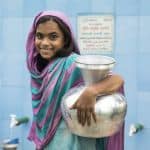Why Hand Hygiene Is the Perennial Third Wheel of WASH – and How It Can (Finally) Become a Global Development Priority
There is a longstanding imbalance in the global WASH (water, sanitation, hygiene) sector: For decades, the focus has alternated between clean water and safe toilets, while handwashing remains perennially neglected.
This lack of emphasis extends to both money and mentality: Water and sanitation tend to require large capital expenditures on visible infrastructure, while hygiene tends to be seen as little more than a behavior to promote and encourage. The result is a vast difference in responses: Governments build a multi-billion dollar piped-water system — and put up posters reminding people to wash their hands.
Unfortunately, these posters are mostly useless if people do not have conveniently available sinks. The late Val Curtis of the London School of Hygiene and Tropical Medicine was at the forefront of collecting evidence on the importance of appropriate settings in enabling handwashing behavior, and her colleagues are continuing those efforts. A key takeaway from this research: Facilities matter. People are not more likely to wash their hands properly after reading public awareness messages on the bus or a billboard, but they are twice as likely to do so when a nice sink is conveniently available.
This makes intuitive sense. Few people wash their hands when the sink is far away, or when the facilities are filthy and splash mud on their feet. This concept has long been understood as it relates to toilets: We do not expect people to stop open defecation without conveniently available toilets. Granted, having nice facilities does not guarantee usage, but it makes the desired behaviors more pleasant, safer and more consistent.
The Token Focus on Handwashing During COVID-19
Given the ravages of COVID-19 — against which handwashing is critical — one would have expected a major shift in attention and investment toward handwashing facilities. Unfortunately, that has not materialized. Instead, leaders in the WASH sector have increased funding calls for water and sanitation, with mostly token references to hygiene. A handbook issued in response to COVID-19 by Sanitation and Water for All (the leading WASH forum that convenes government ministers) typifies the sector’s broad neglect of hygiene — the word “hygiene” appears regularly in the handbook, but only to spell out “WASH.” Kevin Rudd, the group’s chair, even neglected to mention it in the book’s forward, in which he called out the fundamental need to provide “water and sanitation for all.”
There is little question of the importance of clean water and sanitation, and of the noble aims of Rudd and his organization. Unclean drinking water and a lack of toilets are responsible for an enormous and perennial burden of disease around the globe, estimated by UNICEF to be over US $260 billion each year in developing countries. But access to water does not equate to access to sinks and handwashing. Within WASH, the only actual prophylactic against COVID-19 is handwashing. Instead of calling attention to the indirect economic effects of water and sanitation, why not trumpet the fact that hygiene can actually prevent the transmission of the disease causing the disaster that has dominated development work — and daily life — for the past year?
Instead, the funding that has been marked for handwashing has largely been spent on public awareness campaigns, which have no meaningful effect. Even then, these funds are negligible compared to other COVID-response spending: In the U.S. alone, the government’s fiscal response had reached nearly $4 trillion — even before the latest round of stimulus.
Hygiene as a Necessary but Neglected Third Wheel
Like the “H” in WASH, hygiene comes behind water and sanitation in terms of progress, attention and investment — but it doesn’t have to be this way. There are at least three options that could improve the prospects for hygiene: emancipating it from the WASH family, in which it has long been neglected; dramatically shifting the mindset within the WASH sector to elevate hygiene’s rank; or finding innovative ways to achieve hygiene goals “behind the scenes.” Let’s take a look at each option.
Option 1: A Clean Break from WASH
Separating hygiene from water and sanitation would offer several potential advantages. Money talks, so as long as hundreds of billions of dollars are needed to address water and sanitation concerns, they will continue to command majority mindshare while hygiene plays the third fiddle. But it is not only about money: Grouping these three different priorities together deeply affects institutional structures, which can also result in the marginalization of hygiene. The staff within agencies of the United Nations and international NGOs are the ones who implement many WASH initiatives, but they are typically preoccupied with the provision of clean water. Government ministries are also involved, not only in terms of staff responsibilities and technical specializations but more broadly in terms of jurisdiction. If WASH happens to be housed in the Ministry of Agriculture and Rural Development, then that is by default where one will find hygiene (though it may require some looking). If hygiene were seen as independent from WASH, then it would (ideally) have its own staffing, budget and organizational clout in governments and agencies.
However, there would also be some disadvantages to this separation. Finding a new home for hygiene could be a challenge, as it doesn’t fall cleanly in any other sector. For instance, there’s no obvious reason to suspect that hygiene would receive more attention in the health sector, where relevant government agencies and NGOs are occupied with medical services. Worse, the topic could be neglected in areas outside of health care services delivery — notably in schools, care facilities and in the home. The same would be true for the education, early childhood development and nutrition sectors: Each of these depends critically on hygiene for its own success, but none might be willing to embrace the responsibility of promoting something like handwashing with soap alongside their traditional core priorities. This critical initiative could potentially be deprioritized in its next home in the same way it is now.
Option 2: Putting the Sink on a Pedestal
The second option, a wholesale shift in mindset about the hygiene sector, would not be easy. A small, patient and dedicated group of handwashing proponents has been sounding the alarm about inadequate hygiene — even the risks of pandemic contagion — since at least 2008, when they first convinced the UN to create Global Handwashing Day. Including the percentage of households with a dedicated handwashing facility in the measurement of SDG 6.2 was also a hard-won and important achievement. But beyond these victories, success has been limited. This group had hoped that COVID-19 would finally provide the shock needed to change the situation, but it has been disappointed so far.
UNICEF is a rare bright spot, having dedicated an unparalleled amount of attention and resources to this problem. In May 2020, UNICEF began a PR blitz to highlight the gap in infrastructure, including a lack of handwashing facilities. And in June, it launched Hand Hygiene for All, a global initiative with the World Health Organization. UNICEF has also made significant investments in the effort to encourage widespread handwashing, including helping the government of Cambodia equip all schools across the country with facilities for washing hands.
These efforts by UNICEF are encouraging, and they represent the biggest advances toward collective action in hygiene since 2008. But so far, these advances risk being little more than a drop in the proverbial handwashing bucket. The questions remain: What should the global community do when something like access to handwashing facilities is absolutely vital to human advancement and well-being, yet so often overlooked? What should we do with an issue that crosses so many sectors that it lacks any vocal constituency or advocacy base? How can we inspire collective hygiene action across diverse stakeholders, and create an alliance tasked with achieving ambitious objectives and producing real results?
Sadly, few experienced development professionals could read that last sentence without feeling a bit pessimistic or cynical.
Option 3: Bringing Hygiene Up to Code
A less ambitious third option might be more realistic and generate better results. Clues about how it might work can be found in wealthy OECD countries, where handwashing facilities are available where they have been previously viewed as needed: in the kitchen near food preparation and at the toilet, where hands come in contact with feces. If one tried to build a house without a sink in the U.K. or Canada and use it as their family’s primary residence, several departments might intervene, including a child welfare department and authorities that regulate and zone dwellings. It’s doubtful that the homeowner could escape fines by pointing to a dusty tap outside in the garden shed. Builder liabilities, the uninsurability of property and reduced resale value would also discourage the owner from flaunting code.
No one would argue that the rates of handwashing in the U.K. are perfect, but the presence of handwashing stations drastically lowers the risk of chronic infectious disease. Compare that country’s public health statistics to those of an informal settlement in urban India, for instance, where the majority of dwellings have no facilities for handwashing nor sanitation. Young occupants suffer stunting and wasting, along with excess morbidity, at far greater rates than their counterparts in countries like the U.K.
For the three billion people globally who lack handwashing facilities at home, the 900 million students who do not have sinks at school, and the two billion people who rely on health care facilities with inadequate hygiene, the best champions might be their local officials in charge of regulation and building codes. If it became a law that every toilet, every food preparation area, every school, every patient ward and every household must have a functional sink, it might create a shared responsibility across different sectors. An NGO focused on low-cost housing could not responsibly ignore the lack of sinks, regardless of whether or not they had a WASH specialist on their payroll. Early childhood development specialists and nutrition advisors would be obliged to take note if the requisite facilities were not present. School principals could be held accountable if they were not in compliance with explicit provisions for functional handwashing facilities on the premises.
Less Passion, More Routine
Hygiene might never be the star in the WASH family, nor in any other family, but perhaps it need not be. Instead of fighting for the ephemeral spotlight in the global consciousness — competing against every more charismatic issue area — it may be better to embrace hygiene’s status as an addendum. The tedious and thankless work of embedding a line for “well-maintained handwashing facilities” within codes, frameworks, job functions, accountability measures, audits and funding packages will yield better and more sustainable results than waging an endless battle against crisis fatigue. Build the multi-million dollar piped water system, but make sure there is a handwashing sink at the end of the pipe before you cut the ribbon.
Proponents like Rudd may never speak out explicitly for hygiene, but that could be fine so long as their deputies quietly but genuinely embed provisions for handwashing facilities in the final protocols.
Geoff Revell is a WASH practitioner with over 20 years in market-building and systems change in WASH. He’s based in Cambodia, and is also the founder of HappyTap, a hygiene-focused social enterprise.
Photo courtesy of Trocaire.
- Categories
- Coronavirus, WASH
- Tags
- COVID-19, global development, hygiene, water



